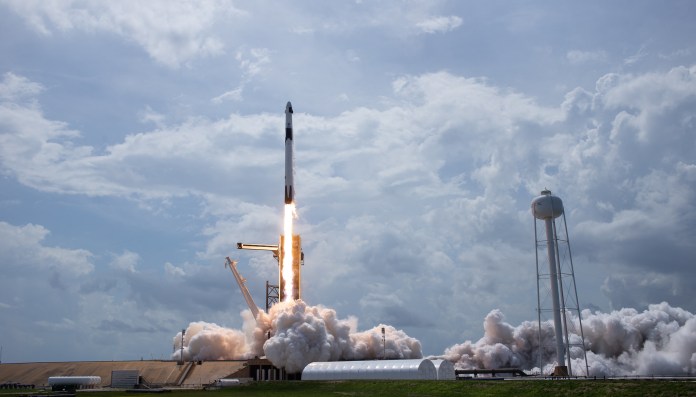By The Conversation, Cassandra Steer
Credit: NASA Kennedy/Flickr
At the weekend, two NASA astronauts were launched by the commercial giant SpaceX of Elon Musk at a spacecraft called Crew Dragon that, by the interior, appeared like a souped-up Tesla.
The spacecraft was launched by the Falcon 9 rocket, returned to Earth and landed to later be re-used.
The flight marks the first time in history:
However, what exactly does this mean for the many companies making a new space business Down Under?
A burgeoning industry that is local
Globally, the space industry is worth at least US$415 billion, and is forecast to rise within the next ten years to US$ 1 trillion.
Infrastructure is developed by an estimated 770 entities. This includes technologies for deep space study or tv weather monitoring and climate monitoring, search and rescue, navigation, telecommunications, and protection and security, and satellites.
The Crew Dragon spacecraft can carry up to seven astronauts. Charge: CC BY-NC, Official SpaceX Photos/Flickr
The global commercial space industry is presently watching Australia with excitement, and maybe some envy. Nations over-regulate their space industries, or don’t provide them legislative support. However, Australia is a new entrant into the space industry that benefits through an industry-dedicated space agency from complete government assistance.
The commercialisation of spacefaring
The 20th century space race began with government plans spurred by a ideological and technological competition between the Soviet Union and the US. But, today’s space race is highly commercial.
Many space programs and militaries outsource to entities for space services. The Department of Defense signed a contract to create rockets for military satellites and cargo this past month.
Rather than big, expensive technologies developed for single functions by government agencies, we’re currently in an age of”NewSpace”. This is a phrase associated with small and medium sized companies creating lighter, smaller, and so cheaper technologies that can be repurposed and flipped to”off the shelf” components.
Giants such as SpaceX and Blue Origin are developing technologies along with their bigger launching projects, when it comes negotiating public-private partnerships, and smaller companies benefit from their success.
The SpaceX Crew Dragon spacecraft lifted off atop a SpaceX Falcon 9 rocket from Launch Complex 39A at NASA’s Kennedy Space Center. Credit: NASA Kennedy/Flickr
Mindsets pave the way
Even the opening of our spaceport in East Arnhem land, anticipated by early 2021, is thanks to industry creation.
Company Equatorial Launch Australia is the first commercial company to be given a launch contract. As a result, the spaceport, in which it will specialize in brand new launching technologies for mild and small satellites is being developed by the company.
And besides NASA, research institutes and many companies will be eager customers. Inovor, which assembles tiny nanosatellites may be among the earliest.
Or perhaps Gilmour, since it tests a revolutionary propulsion rocket in partnership. This might be its type to start in the world’s first commercial rocket.
NASA astronauts Bob Behnken and Doug Hurley piloted the Crew Dragon. It’s the first spacecraft to carry people into space. Credit: NASA Kennedy/Flickr
In the space, a pandemic market booms
According to a report released in May by accounting firm KPMG, by 2030 every company will be a”space business.” The report suggests humans will live, work and holiday in space, and will be mining the moon for minerals and water.
And while human space flight out of Australian beaches may not be on the horizon, SpaceX’s launching is a beacon of hope for entities that are industrial that are neighborhood since they push new technologies than government programs tethered into budgets and approaches that are low-risk.
In Addition, the ASA is currently considering entering into an Artemis Accord with the US. The launching tech demonstrated by SpaceX this weekend will be a part of the Artemis program, which intends to return people to the moon.
So although the federal and global market reels in the consequences of COVID-19 shutdowns, the global space market continues to flourish. And with Australia’s space industry taking off, the sky is not the limit.
– Advertisement –
